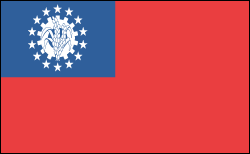Geography | Government | HistoryGeographySlightly smaller than Texas, Myanmar occupies the Thailand/Cambodia portion of the Indochinese peninsula. India lies to the northwest and China to the northeast. Bangladesh, Laos, and Thailand are also neighbors. The Bay of Bengal touches the southwest coast. The fertile delta of the Irrawaddy River in the south contains a network of intercommunicating canals and nine principal river mouths. GovernmentMilitary regime. HistoryThe ethnic origins of modern Myanmar (known historically as Burma) are a mixture of Indo-Aryans, who began pushing into the area around 700 B.C., and the Mongolian invaders under Kublai Khan who penetrated the region in the 13th century. Anawrahta (1044–1077) was the first great unifier of Myanmar. In 1612, the British East India Company sent agents to Burma, but the Burmese doggedly resisted efforts of British, Dutch, and Portuguese traders to establish posts along the Bay of Bengal. Through the Anglo-Burmese War in 1824–1826 and two subsequent wars, the British East India Company expanded to the whole of Burma. By 1886, Burma was annexed to India, then became a separate colony in 1937. WWII Leads to IndependenceDuring World War II, Burma was a key battleground; the 800-mile Burma Road was the Allies' vital supply line to China. The Japanese invaded the country in Dec. 1941, and by May 1942, had occupied most of it, cutting off the Burma Road. After one of the most difficult campaigns of the war, Allied forces liberated most of Burma prior to the Japanese surrender in Aug. 1945. Burma became independent on Jan. 4, 1948. In 1962, left-wing general Ne Win staged a coup, banned political opposition, suspended the constitution, and introduced the “Burmese way of socialism.” After 25 years of economic hardship and repression, the Burmese people held massive demonstrations in 1987 and 1988. These were brutally quashed by the State Law and Order Council (SLORC). In 1989, the military government officially changed the name of the country to Myanmar. (The U.S. State Department does not recognize the name Myanmar or the military regime that represents it.) The Military Maintains A Tight Grip On MyanmarIn May 1990 elections, the opposition National League for Democracy (NLD) won in a landslide. But the military, or SLORC, refused to recognize the election results. The leader of the opposition, Aung San Suu Kyi, was awarded the Nobel Peace Prize in 1991, which focused world attention on SLORC's repressive policies. Daughter of the assassinated general Aung San, who was revered as the father of Burmese independence, Suu Kyi remained under house arrest from 1989 until 1995. Suu Kyi continued to protest against the government, but almost every move she made was answered with a counterblow from SLORC. Although the ruling junta has maintained a tight grip on Myanmar since 1988, it has not been able to subdue an insurgency in the country's south that has gone on for decades. The ethnic Karen movement has sought an independent homeland along Myanmar's southern border with Thailand. In Jan. 2004, the military government and the insurgents from the Karen National Union agreed to end the fighting, but they stopped short of signing a cease-fire. The economy has been in a state of collapse except for the junta-controlled heroin trade, the universities have remained closed, and the AIDS epidemic, unrecognized by the junta, has gripped the country. The Junta Crack Down On DemocracyFrom 2000 to 2002, Suu Kyi was again placed under house arrest. In spring 2003, the government cracked down once again on the democracy movement, detaining Suu Kyi and shuttering NLD headquarters. The regime opened a constitutional convention in May 2004, but many observers doubted its legitimacy. In October 2004, the government arrested Prime Minister Gen. Khin Nyunt and charged him with corruption. He had angered the leadership of the junta with his recent experiments on reform, first by freeing Suu Kyi from house arrest and later for proposing a seven-step “road map to democracy.” A series of coordinated bomb attacks in May 2005 killed about a dozen people and wounded more than 100 in Rangoon. The military junta blamed the Karen National Union and the Shan State Army. The ethnic rebel groups, however, denied any involvement. Moving Toward A Modern NationOn November 13, 2005, the military junta—in a massive and secretive move—relocated the seat of government from the capital Rangoon to a mountain compound called Pyinmanaa in Naypyidaw. The move perplexed many, and the junta was vague in its explanation, saying, “Due to changed circumstances, where Myanmar is trying to develop a modern nation, a more centrally located government seat has become a necessity.” More than 1,000 delegates gathered in December to begin drafting a constitution, which the junta said was a step toward democracy. The convention adjourned in late January 2006 with little progress. In Sept. 2007, representatives to the convention, which has met on and off since 1993, released a draft constitution that ensures that the military will continue to control the ministries and legislature and have the right to declare a state of emergency. The document also limits the rights of political parties. Opposition parties were excluded from the convention. Military Crackdowns Receive World CriticismIn a stunning show of defiance, widespread pro-democracy protests, prompted by a sharp increase in fuel prices, erupted throughout the country in August 2007. Participation in the peaceful protests ballooned over several weeks, and Buddhist monks joined the throngs of protesters when government troops used force against demonstrators in early September. The monks emerged as the leaders of the protest movement and gained international sympathy and support. On September 26, the military cracked down on the protesters, firing into crowds, raiding pagodas, and arresting monks. At least nine people were killed. The protests were by far the largest in the country in 20 years, with as many as 100,000 people marching. In a statement, the United Nations Security Council condemned the crackdown, saying it "strongly deplores" the violence unleashed on the protesters. On May 3, 2008, Cyclone Nargis ravaged the Irrawaddy Delta and Yangon, killing 22,500 people and leaving up to a million homeless. Another 41,000 people were reported missing and feared dead. Most of the death and destruction were caused by a 12-foot high tidal wave that formed during the storm. The isolated military junta accepted international aid, a tacit acknowledgement that it is ill-equipped to handle a disaster of such enormous scope. But once the aid began to arrive, the government limited distribution of the supplies, accepting only about 10% of what was needed. In addition, it denied entry visas to relief workers, leaving the country crippled and vulnerable to widespread disease. The junta faced further criticism when it went ahead with a constitutional referendum on May 10 intended to cement its grip on power. In September, the military government released just over 9,000 prisoners, including the longest-serving political prisoner, Win Tin. Most of those released, however, were not political prisoners. By most estimates, as many as 2,000 political prisoners remain in detention. These releases were followed in November by the sentencing of 30 activists to up to 65 years in jail. The activists include veterans of the 1988 students' movement and other democracy advocates who participated in the thwarted monk-led protests in August and September 2007. | ||||
Study the history and geography of modern Myanmar (known historically as Burma) with this country profile.
Infoplease
Provided by Infoplease—an authoritative, comprehensive reference website that offers an encyclopedia, a dictionary, an atlas, and several almanacs. Visit Infoplease.com to find more resources endorsed by teachers and librarians.






